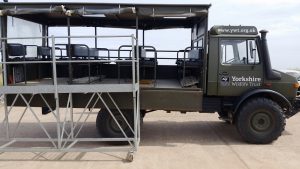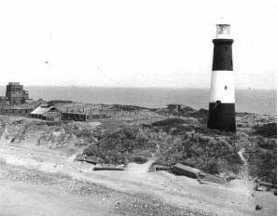GB2SL International lighthouse on the air weekend 19th 20th August 2017
International lighthouse on the air GB2SL Spurn Lighthouse
Location information Lighthouses: Numbers
LOC: JO Ø3 BN UK0080=Spurn Point High
WAB: TA-41 UK0081=Spurn Point Low
LAT: 53.578978n Spurn Head (old): A2424X
LNG: 0.06.33 E
NGR: TA 41153 11282
This year we have been invited by the Yorkshire Wildlife Trust, to put on a station during International Lighthouse on the air weekend, as part of the celebrations on completion of the restoration of the Spurn High Light as a visitor attraction the tallest lighthouse in Northern England!
Made of 300,000 Staffordshire bricks, with a height of 128ft (39m) and 145 steps to the top landing, providing a spectacular view of Spurn nature reserve and the river Humber.
It is 7 years since HF DX A.R.C were last down at Spurn Point to activate GB2SL.
We are pleased to have been invited back by the Yorkshire Wildlife Trust to help promote the restored Spurn High lighthouse.
Since our last visit there has been changes to the shape of Spurn Point and it is now inaccessible to road transport due to the storms of 2013.
With at least 200yrd break between the mainland and Spurn point making a
newly created island at high tide.
We are taking a small team of 8, regrettably only those who can climb can attend this event, manpower and equipment will be ferried to the site by the YWT, in “or should that be on” their Unimog all-terrain vehicle.
The team will also have to climb the lighthouse all 145 steps.
The height of 128ft will give us a good take-off to contact the world.
Because of the 200yrd break in the road way, it is a one-way operation in between tides, all previsions for the weekend have to be taken down, there is no nipping down to the local shops.
An essential at this time of year is insect repellent and sting cream, there are some very irritating insects and caterpillars in the bushes at spurn.
The only people left on Spurn during high tide will be the HFDXARC team and the Humber lifeboat crew, who are half a mile away along the dunes.
We are preparing to transmit on 80m, 40m, 20m with provision if needed for 17m and 12m
and shall be taking delta loops for 20m and 40m, but also wire dipoles
With Height, sea on 3 sides and good antennas we are set to set the air waves alight and talk to the world.
If the bands are open.
History of Spurn Point
Spurn Head, or Spurn Point, the present peninsula at the southern tip of South Holderness, is a three-and-a-half-mile line of sand and shingle, which stretches out between the North Sea and the River Humber in a south-westerly direction.
A peninsula in one form or another has existed here since the first one was formed after the retreat of the ice at the end of the last Ice Age. How such a peninsula comes into existence and how it develops and changes cannot be certainly proven. Its course is not fixed, because it is attached to one of the fastest eroding coasts in the world — the Holderness coast.
One theory, supported by historical records, postulates a cyclical history of about 250 years for each of the various peninsulas, which have grown gradually as a result of long-shore drift of material washed out of the clay cliffs to the north. The profile of each peninsula, which grows from a stump, is low, allowing a certain amount of wash-over of sand, which helps to build it up on the western side, whilst most of the material moves further south and forms a spoon-shaped point. With the rapid erosion of the coast to which it is attached, a breach is inevitable eventually, and once the sea gets through, the head becomes isolated and gradually washes away. A new peninsula then forms a little to the west and the cycle starts again.
It is not possible to test these theories thoroughly because since mid-Victorian times Spurn has been kept in place by artificial coastal defences. For centuries Spurn was owned by the Constable family, the Seigniors of Holderness, who lived at Burton Constable. When the War Office wished to establish Spurn Fort to protect the Humber in World War I, it leased the peninsula from the Constables, and in 1925 the War Office bought it from the Constables by compulsory purchase.
The military held a presence and maintained the sea defences of spurn until the 1950s when it was deemed no longer needed for defence purposes.
Since then the sea defences that had been maintained for almost a 100 year have started to deteriorate.
History of Spurn Lighthouses
Lighthouses have been located on Spurn for over five hundred years. The first reference to a lighthouse on Spurn dates back to 1427 “reign of King Henry vi”, when a hermit, William Reedbarrow, was granted dues from passing ships to complete a lighthouse which he had begun to build there, though little further is known about it. In the late 17th century a high and a low light were erected on what was then the tip of the spit, probably about two miles north of the present tip.
There is little record of what Spurn’s earlier lighthouses looked like, but we do know they have been built in pairs since 1674 and at least eight have been swept away in storms.
The low light had to be rebuilt several times, but the high light lasted until the late 18th century, when John Smeaton, the celebrated engineer who had built the Eddystone lighthouse in 1759, designed and built two new lighthouses, under the direction of the Hull and London Trinity Houses. In 1852, a new low lighthouse was built on the Humber foreshore.
In 1895 there was evidence that the foundations of Smeaton’s lighthouse were cracking, the present lighthouse was designed by Thomas Matthews of Edinbinbugh, it stands on an artificial rock foundation that goes down 22 feet (7m) and took nearly two years to build. Later the oil lamp was converted to electricity (1941) and gas (1957) on which it ran until 1985 when it was last used.
However, when the present lighthouse was built, the low light was no longer needed as three additional lamps were placed in the body of the lighthouse instead. It has since been used as an explosive store and a water tower. Now it stands deserted.
The sand spit that is now part of the Yorkshire Wildlife Trust is approximately 3.5 miles in length. With the split/separation in recent years extending to about 200 yards/metres from the main land.
The Spurn Lighthouse (Reputably built on cotton bails, to aid with stability.) has been fully refurbished by the Yorkshire Wildlife Trust and is now open to the public daily, dependent on tides.
The new refurbishment by the YWT will enable visitors to experience the wondrous views from the top of the Lighthouse, looking back at the River Humber looking out to sea and the East Yorkshire coast. A splendid view not to be missed.





You must be logged in to post a comment.